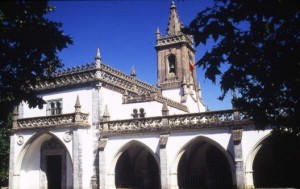 The first museum in Beja was, undoubtedly, made possible by the personal collections of friar Manuel do Cenacle (1724.1814), the illustrious prelate of Beja, whose merits and jealous investigator skills , attracted the attention of the cultural world of the time. The cenacle investiture of the archbishopric of Evora brought about the bringing of different monuments to that city. This moving was counterproductive for Beja, but it was absolutely within the epoch’s tendency, and was done during the life of this erudite bishop.
The first museum in Beja was, undoubtedly, made possible by the personal collections of friar Manuel do Cenacle (1724.1814), the illustrious prelate of Beja, whose merits and jealous investigator skills , attracted the attention of the cultural world of the time. The cenacle investiture of the archbishopric of Evora brought about the bringing of different monuments to that city. This moving was counterproductive for Beja, but it was absolutely within the epoch’s tendency, and was done during the life of this erudite bishop.
The scattering, from the old Museum Sesinando–Cenáculo-Pacense (Beja), of tombstones and ornamented stones, that were not taken to Evora, were lost right then. But more than two dozens of the more precious ones, were recovered, thanks to the self-denying cooperation of D. António Xavier de Sousa Monteiro, bishop of Beja’s Catholic Head-Office, as when these items were, one by one, discovered at the Episcopal Palace, were ordered by the Bishop to be returned to Beja’s Town-Hall.
 After the passing of eight decades, and during a session on the 5th. Of March 1890, Dr. Manuel Duarte Laranja Gomes Palma, Mayor of Beja’s City Council, proposed that the objects stored in an upper floor of the Town-Hall, be moved to a small museum representative of the town, which was inaugurated after a few sessions, dealing with the details related to these objects, and this happened on the 29 of December 1892 (a Thursday) with the new name of Archeological Municipal Museum of Beja.
After the passing of eight decades, and during a session on the 5th. Of March 1890, Dr. Manuel Duarte Laranja Gomes Palma, Mayor of Beja’s City Council, proposed that the objects stored in an upper floor of the Town-Hall, be moved to a small museum representative of the town, which was inaugurated after a few sessions, dealing with the details related to these objects, and this happened on the 29 of December 1892 (a Thursday) with the new name of Archeological Municipal Museum of Beja.
The real soul of the Museum, was, however, the Head City Council Secretary, José Umbelino Palma, whose activity in favor of that Institution was manifested mainly in the local newspaper, “O Bejense”, of which he was the Director. The vast quantity of the offers and items, filled several rooms in such a way that, in 1898, all these objects were distributed in various rooms of the Town-Hall building.
 During the years of 1927/28 the Museum collections were moved to the actual building of the Convent of our Lady of the Conception, and were increased with religious art objects proceeding from demolished churches and extinct convents of the city, such as paintings, andors, images, ornaments, jewelleries and several cult household furniture.
During the years of 1927/28 the Museum collections were moved to the actual building of the Convent of our Lady of the Conception, and were increased with religious art objects proceeding from demolished churches and extinct convents of the city, such as paintings, andors, images, ornaments, jewelleries and several cult household furniture.
On that date, and following a previous decree, the Regional Museum of Beja’s tutelage was passed from the Town-Hall to the old General Council District, the actual District Assembly of Beja. Organism from whom the actual Museum Rainha D. Leonor depends administratively.
